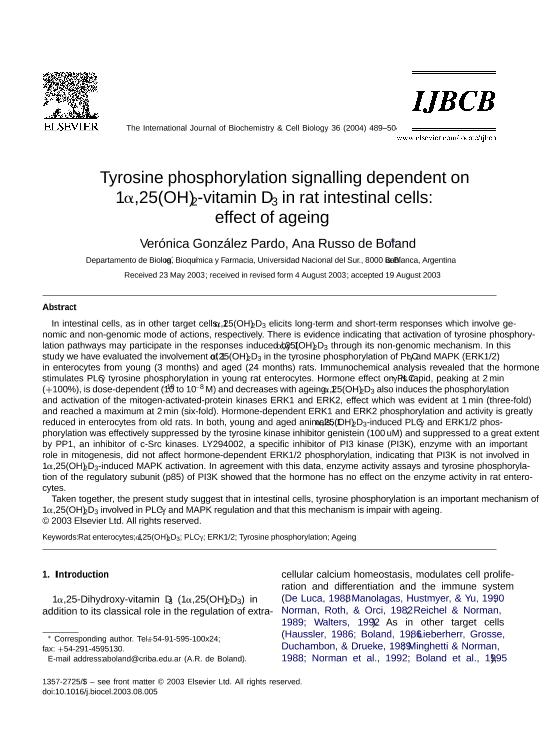Mostrar el registro sencillo del ítem
dc.contributor.author
González Pardo, María Verónica

dc.contributor.author
Russo, Ana Josefa

dc.date.available
2020-02-17T22:50:50Z
dc.date.issued
2004-12
dc.identifier.citation
González Pardo, María Verónica; Russo, Ana Josefa; Tyrosine phosphorylation signalling dependent on 1α,25(OH) 2-vitamin D3 in rat intestinal cells: Effect of ageing; Pergamon-Elsevier Science Ltd; International Journal of Biochemistry and Cellular Biology; 36; 3; 12-2004; 489-504
dc.identifier.issn
1357-2725
dc.identifier.uri
http://hdl.handle.net/11336/97863
dc.description.abstract
In intestinal cells, as in other target cells, 1α,25(OH) 2D3 elicits long-term and short-term responses which involve genomic and non-genomic mode of actions, respectively. There is evidence indicating that activation of tyrosine phosphorylation pathways may participate in the responses induced by 1α,25(OH)2D 3 through its non-genomic mechanism. In this study we have evaluated the involvement of 1α,25(OH)2D3 in the tyrosine phosphorylation of PLCγ and MAPK (ERK1/2) in enterocytes from young (3 months) and aged (24 months) rats. Immunochemical analysis revealed that the hormone stimulates PLCγ tyrosine phosphorylation in young rat enterocytes. Hormone effect on PLCγ is rapid, peaking at 2min (+100%), is dose-dependent (10-10 to 10-8M) and decreases with ageing. 1α,25(OH)2D3 also induces the phosphorylation and activation of the mitogen-activated-protein kinases ERK1 and ERK2, effect which was evident at 1min (three-fold) and reached a maximum at 2min (six-fold). Hormone-dependent ERK1 and ERK2 phosphorylation and activity is greatly reduced in enterocytes from old rats. In both, young and aged animals, 1α,25(OH)2D3-induced PLCγ and ERK1/2 phosphorylation was effectively suppressed by the tyrosine kinase inhibitor genistein (100uM) and suppressed to a great extent by PP1, an inhibitor of c-Src kinases. LY294002, a specific inhibitor of PI3 kinase (PI3K), enzyme with an important role in mitogenesis, did not affect hormone-dependent ERK1/2 phosphorylation, indicating that PI3K is not involved in 1α,25(OH) 2D3-induced MAPK activation. In agreement with this data, enzyme activity assays and tyrosine phosphorylation of the regulatory subunit (p85) of PI3K showed that the hormone has no effect on the enzyme activity in rat enterocytes. Taken together, the present study suggest that in intestinal cells, tyrosine phosphorylation is an important mechanism of 1α,25(OH)2D3 involved in PLCγ and MAPK regulation and that this mechanism is impair with ageing.
dc.format
application/pdf
dc.language.iso
eng
dc.publisher
Pergamon-Elsevier Science Ltd

dc.rights
info:eu-repo/semantics/openAccess
dc.rights.uri
https://creativecommons.org/licenses/by-nc-nd/2.5/ar/
dc.subject
1Α,25(OH)2D3
dc.subject
AGEING
dc.subject
ERK1/2
dc.subject
PLCΓ
dc.subject
RAT ENTEROCYTES
dc.subject
TYROSINE PHOSPHORYLATION
dc.subject.classification
Bioquímica y Biología Molecular

dc.subject.classification
Ciencias Biológicas

dc.subject.classification
CIENCIAS NATURALES Y EXACTAS

dc.title
Tyrosine phosphorylation signalling dependent on 1α,25(OH) 2-vitamin D3 in rat intestinal cells: Effect of ageing
dc.type
info:eu-repo/semantics/article
dc.type
info:ar-repo/semantics/artículo
dc.type
info:eu-repo/semantics/publishedVersion
dc.date.updated
2020-02-13T14:04:49Z
dc.journal.volume
36
dc.journal.number
3
dc.journal.pagination
489-504
dc.journal.pais
Estados Unidos

dc.description.fil
Fil: González Pardo, María Verónica. Universidad Nacional del Sur. Departamento de Biología, Bioquímica y Farmacia; Argentina. Consejo Nacional de Investigaciones Científicas y Técnicas; Argentina
dc.description.fil
Fil: Russo, Ana Josefa. Universidad Nacional del Sur. Departamento de Biología, Bioquímica y Farmacia; Argentina. Consejo Nacional de Investigaciones Científicas y Técnicas; Argentina
dc.journal.title
International Journal of Biochemistry and Cellular Biology

dc.relation.alternativeid
info:eu-repo/semantics/altIdentifier/doi/http://dx.doi.org/10.1016/j.biocel.2003.08.005
dc.relation.alternativeid
info:eu-repo/semantics/altIdentifier/url/https://www.sciencedirect.com/science/article/pii/S1357272503002954
Archivos asociados
